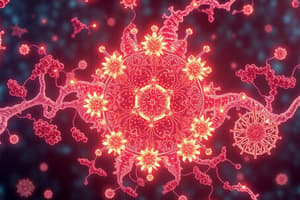Podcast
Questions and Answers
How many multi-subunit large enzyme complexes are involved in the transfer of electrons from NADH and FADH2 to the ETC?
How many multi-subunit large enzyme complexes are involved in the transfer of electrons from NADH and FADH2 to the ETC?
Four multi-subunit large enzyme complexes are involved in the transfer of electrons from NADH and FADH2 to the ETC.
What is the function of an electron transport chain (ETC)?
What is the function of an electron transport chain (ETC)?
The function of an electron transport chain is to transfer electrons from electron donors to electron acceptors via redox reactions and couple this electron transfer with the transfer of protons across a membrane, generating a proton gradient that drives ATP synthesis.
What is the consequence of the flow of electrons through the electron transport chain?
What is the consequence of the flow of electrons through the electron transport chain?
The flow of electrons through the electron transport chain is an exergonic process that creates an electrochemical proton gradient, driving the synthesis of ATP.
In anaerobic respiration, what are some examples of electron acceptors used?
In anaerobic respiration, what are some examples of electron acceptors used?
In aerobic respiration, what is the final electron acceptor in the flow of electrons through the electron transport chain?
In aerobic respiration, what is the final electron acceptor in the flow of electrons through the electron transport chain?
Flashcards are hidden until you start studying
Study Notes
Electron Transport Chain
- There are four multi-subunit large enzyme complexes involved in the transfer of electrons from NADH and FADH2 to the ETC.
Function of Electron Transport Chain
- The electron transport chain (ETC) generates a proton gradient across the inner mitochondrial membrane, driving ATP synthesis.
Consequence of Electron Flow
- The flow of electrons through the electron transport chain generates a proton gradient, which is used to produce ATP through chemiosmosis.
Electron Acceptors
- In anaerobic respiration, examples of electron acceptors used include sulfate, nitrate, and ferric ions.
- In aerobic respiration, the final electron acceptor in the flow of electrons through the electron transport chain is oxygen (O2).
Studying That Suits You
Use AI to generate personalized quizzes and flashcards to suit your learning preferences.




